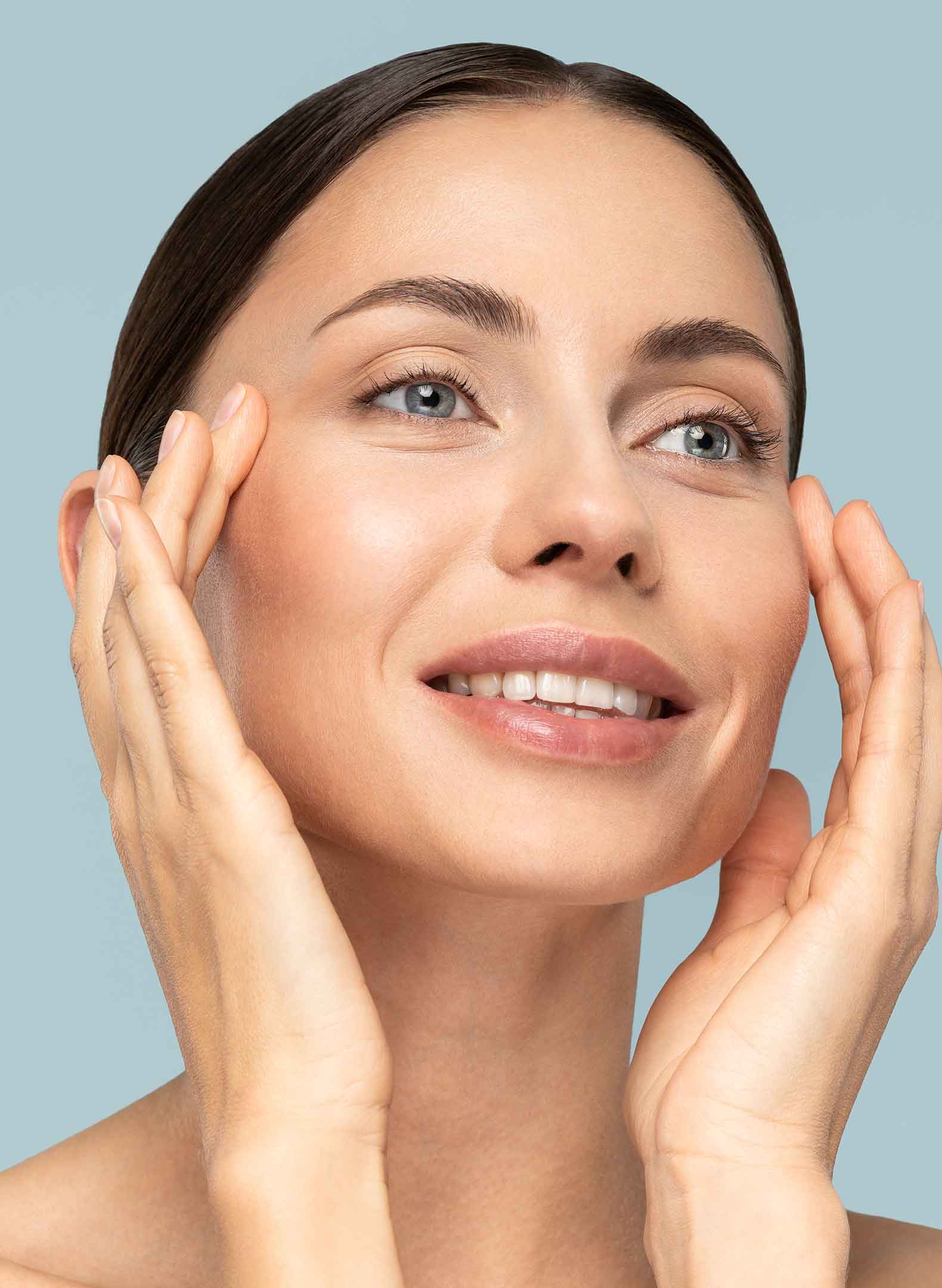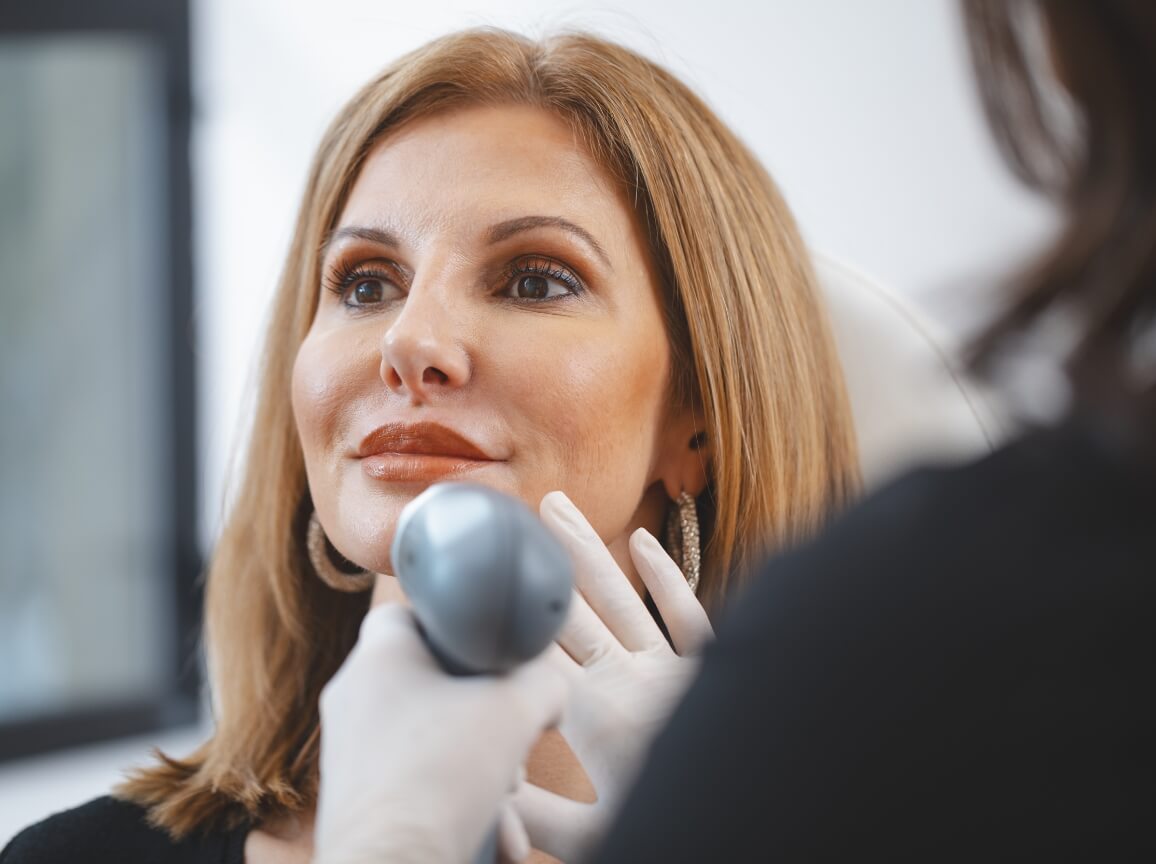Superficial Chemical Peels In Grass Valley, CA
 Model
Model
Your skin is still vibrant, but that might be hidden in a deeper layer that needs to be uncovered. Environmental factors such as sun exposure, smoking, pollutants, and the natural aging process all take a toll on the skin–and after a while, it needs a reset. Chemical peels have long provided custom treatment of a variety of skin concerns, like wrinkles and deep creases, pigmentation problems, textural and tonal irregularities, acne scarring, and more, without the need for heat, light, or surgery.
 Model
Model
Dr. Lattyak and our team at the Élan Clinic are proud to offer a wide range of chemical peel options to best serve our patients–from superficial to deep Hetter and TCA peels–with a commitment to effective and safe care.
What Are Chemical Peels?
A chemical peel is a non-surgical skin resurfacing treatment in which a chemical solution is applied to the skin to remove its top layers. After a period of recovery, during which dead or damaged skin peels off, new skin growth occurs, revealing smooth, even skin.
Chemical peels are used to treat wrinkles, discoloration, sun damage, age spots, and imperfections such as acne and acne scarring. They have varying intensities, depending on the depth of penetration. The deeper the peel, the higher the level of intensity and healing time, and the greater amount of correction and more dramatic results that can be expected.
Learn More About Dr. LattyakWhat Are the Benefits of Chemical Peels?
Used in aesthetics for decades with great success, chemical peels are a non-surgical solution for mild to moderate signs of aging, stubborn pigmentation issues, and even acne scars. The process essentially involves removing a layer (or more) of skin, thereby improving any textural or tonal irregularities that are present. A chemical peel serves as a skin reset and can provide a range of benefits without the need to heat the skin or use other more invasive methods like surgery.
Another benefit of chemical peels is their inherent versatility: our experienced Medspa team is well-versed in creating the ideal formula for each patient. Rather than adjusting energy levels on a laser device, for example, a chemical peel gives providers much more flexibility in crafting the ideal measure of ingredients to suit your skin’s needs exactly.
Am I a Candidate for Chemical Peels?
Chemical peels, while effective, are not for everyone. Candidates must be carefully vetted prior to this procedure to limit the risks of side effects or complications. Patients with darker skin tones or those who tend to form raised scars (keloids) may not be candidates for certain deep peels. The best candidates for chemical peels:
- Have mild to moderate facial wrinkles and creases
- Have textural irregularities like acne scars and uneven skin
- Have sun damage, age spots, or hyperpigmentation
- Are not pregnant or breastfeeding
- Are not allergic to any of the active ingredients in the peels
A chemical peel can provide fantastic results for your skin, but it is essential that you have an experienced medical professional determine the best option for you.
What Are My Chemical Peel Options?
Superficial Chemical Peels
Light or superficial chemical peels remove only the top layer of skin (epidermis) and are used to treat fine lines and wrinkles, acne and superficial acne scarring, uneven skin tone and texture, and dry, dull skin. These peels are more gentle than deeper peels, but still provide noticeable improvement to the above concerns. Patients with darker skin tones or who have more sensitive skin may benefit from this type of peel, although multiple treatments are typically necessary for desired results.
Deep Chemical Peels
We offer two types of deep chemical peels at the Élan Clinic: TCA peels and Hetter peels.
Hetter peels, also called croton oil peels or modified phenol peels, are the newest improvement upon the older Baker-Gordon peel, which used a higher concentration of phenol. Today, Hetter peel formulas have been adjusted towards a higher concentration of croton oil rather than phenol, resulting in better results with shorter downtime and lower risk. The Hetter peel depth can be controlled by adjusting the concentration of croton oil and the amount of solution applied, depending on which part of the face is being treated, the patient’s skin type, and the degree of correction needed. When a full face peel is performed, typically several different croton oil concentrations are used for different facial regions. This allows tremendous flexibility in customizing the peel to give you the best results.
Trichloroacetic acid (TCA) peels are another popular medium-to-deep chemical peel that removes a uniform layer of skin from the epidermis and/or dermis (depending on the intensity of the formula) to improve fine lines and wrinkles, uneven skin tone, and acne. TCA peels can also be adjusted for required depth and intensity, although at the concentrations typically used they are generally less deep than Hetter peels.
Combining Your Chemical Peel with Other Procedures
Chemical peels are an essential part of skin rejuvenation for patients of all ages. Their versatile applications and formulas allow our team to adjust them exactly to the patient’s needs. While it may not be recommended to undergo a chemical peel simultaneously with another procedure, there are many options available for enhancing the results of your chemical peel or the peel enhancing the results of another procedure.
 Model
Model
Facelift or Mini Facelift
If you’ve had a facelift in the past, or you are planning one in the future, a chemical peel can be a great addition to your surgical plan to discuss with Dr. Lattyak. Chemical peels work on the surface to mid-layers of the skin, smoothing creases and textural irregularities, while facelifts lift the deep tissues and structures of the face. Typically the chemical peel is scheduled a few months before or after the facelift to create a smooth and youthful base to the skin’s texture that enhances your surgical results greatly.
 Model
Model
Hydrafacial®
A Hydrafacial® is a deeply nourishing, hydrating treatment that can help soothe the skin after the recovery period of a chemical peel. While your skin will be newly resurfaced after your chemical peel, you can maintain the results of this treatment with monthly Hydrafacial®s for gentle exfoliation and the removal of dirt, sebum, and oil for hydrated, glowing skin.
 Model
Model
JUVÉDERM® or Restylane® Dermal Filler Injections
Aging results in a loss of volume in the face, causing deep creases and wrinkles to progress. Chemical peels do not restore volume, so combining your resurfacing treatment with dermal filler injections can provide balance to the structures of the face and create a more cohesive result. Dr. Lattyak will typically space out your chemical peel treatments and dermal fillers for best results.
How Is a Chemical Peel Administered?
Your Consultation
A consultation is required to determine your skin concerns, your goals for the procedure, and the best chemical peel for your skin type. Dr. Lattyak or one of our experienced aesthetic providers will examine your skin, listen to your goals and concerns, and walk you through the options we offer for your chemical peel. Once we determine the ideal chemical peel plan to achieve your desired results, we will thoroughly discuss the risks and benefits of the peel, including how to prepare for your appointment and what recovery might look like.
If you are interested in a chemical peel and would like to find out which option is best for you, call the Élan Clinic today at (530) 273-3400 to schedule a consultation.
Skin Preparation
Regardless of the chemical peel chosen, all patients must avoid excessive sun exposure and certain medications for a specified period of time before and after their peel. Patients should also refrain from bleaching, waxing, scrubbing, massaging or using depilatories (topical hair removal products) and scrubs one week before the peel.
Deeper peels also require priming of the skin for four or more weeks prior to the peel, consisting of applying skin lightening agents and sunscreens. Priming is typically stopped three to five days before the procedure.
Prophylactic antiviral medication is also started two days prior to the peel and continued for 10–14 days after peeling or until the new skin has completely healed.
The Chemical Peel Procedure
You should come to your appointment with clean, product-free skin. Your provider may begin treatment by lightly cleansing your skin or by preparing the skin with a topical anesthetic. Not all peels require anesthesia, but most deep peels do.
The peel will be applied to your face with a cotton swab or brush. Depending on the type of peel you have, the formula may be applied in one even layer or with multiple layers in precise concentrations.
Your peel will be left on the treatment area for a specific amount of time before it is removed. We may also use a neutralizing solution before removing the peel. Depending on the type of peel administered, your skin will be cleansed and coated with petroleum ointment or a mask and protected with sunscreen or a gentle moisturizer.
 Model
Model
What Is Chemical Peel Recovery Like?
Chemical peel recovery will vary depending on the level of depth of the specific peel. All peels will result in some redness, tightness, and irritation. We will provide you with specific instructions for caring for your skin, how to protect your healing skin, and what to expect in the days and weeks to follow. Generally, here is what you can expect from chemical peel recovery:
After a superficial peel, expect your skin to be red, dry, and slightly irritated, sometimes even swollen. It should be noted that if you have multiple sessions of a superficial peel, your side effects may lessen each time. You will likely be asked to use a thick protective ointment in lieu of other cosmetic or skincare products–something like petroleum jelly or a vitamin ointment. You may be able to wear makeup the following day, but your skin will go through a period of shedding, with uneven patches of color and skin texture. Recovery from a superficial chemical peel typically takes about a week.
The recovery period for medium-to-deep peels, like the Hetter or TCA peel, is longer, usually several weeks. You should expect moderate-to-severe redness, swelling, and irritation; your skin will have gone through an intense resurfacing treatment, which will certainly show in its appearance. You may also experience some lingering stinging, which can be soothed with protective ointments and cold compresses. You may also be sent home with gauze to protect your skin.
For deep peels, you may need over-the-counter pain medication, and you’ll need to apply a moisturizing cream multiple times a day for a few weeks. Most patients will develop new skin after about two weeks, although the skin may be discolored or red. After the new skin grows, you’ll be able to wear cosmetics to cover up the redness which may take a couple of months to clear.
When Will I See My Chemical Peel Results?
Patients can see the results of their superficial peels starting one week after their procedure. You may notice a more even tone and texture, with imperfections appearing lighter. Results may be subtle at first, but with repeated treatments, you can enjoy smoother, more even, brighter skin.
Deep peels can provide dramatic improvements to deep creases and wrinkles, acne and acne scars, and other deep imperfections.These improvements are usually seen within a few weeks of the peel, though it often takes a couple of months for the redness to fade and the final results to be realized. Although nothing stops additional damage to the skin or the natural aging process, the results from a deep chemical peel are long lasting.
How Much Does a Chemical Peel Cost in Grass Valley, CA?
Each chemical peel is tailored to the needs, goals, and skin type of the patient. The price depends on the type of peel you have, the level of necessary revision, and the number of treatments needed for optimum results. We will detail all of this information after a consultation, during which we will create your personalized treatment plan. Then, we will be happy to provide you with an accurate cost estimate.
Schedule A ConsultationLife-changing Results
What Our Patients Are Saying

“I really appreciate the time taken to explain procedures and options by Dr. Lattyak when I came in for multiple procedures stemming from a car accident 10 years ago. Quality work and practically painless!” “I’m a 60 year old teacher, not quite ready to retire. For my end of career time in the classroom I wanted to look more refreshed and youthful. Dr. Lattyak and his staff helped make this dream come true. The results of upper eyelid and brow lift are beautiful and the recovery period was over quickly. Thanks for everything.”
“I am so happy with my experience with Dr. Lattyak, his staff, and my surgery results. I will (and do!) recommend this office to anyone considering surgery.”
“Never had a better treatment. Nurses were great and Dr. Lattyak is remarkable.”

